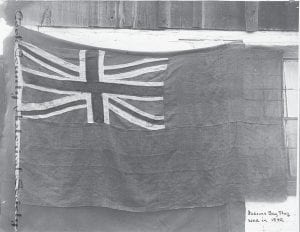The British flag in this photo was given to the Anishinaabe (Ojibwe) people by the British after the War of 1812.
At a community storytelling event in March that focused on Cook County history, Grand Portage National Monument Superintendent Tim Cochrane outlined the history of the early Europeans in this area, saying that the French claimed this area until 1763, after which the British came in, including a few Redcoat guards in 1768. The United States carried on a border dispute with England until 1832, when the line was drawn at the Pigeon River. “If the Brits had had their way,” he said, “we’d all be Canadians right now.”
During the early 1800s, Cochrane said, if you were white, you had to have a license to be in Grand Marais. One of the whites who came here with the European trading business called it “Fort Misery.” In the 1700s, Grand Portage was the biggest city in the Midwest, with a population that swelled to 1,200-2,000 in the summertime – far bigger than any city in the Midwest. Eventually, the international border between the U.S. and Canada split the Ojibwe people, and land policies ended their nomadic way of life. In the 1854 Treaty, the U.S. got mineral rights to the land, and 18 tribes split the $500 they were paid for Isle Royale.
This is part of a series about the tales of Cook County history that were shared at the Arrowhead Center for the Arts on March 9, 2013. The event was called “Stories you’ve never heard – and good ones to hear again!”



Leave a Reply